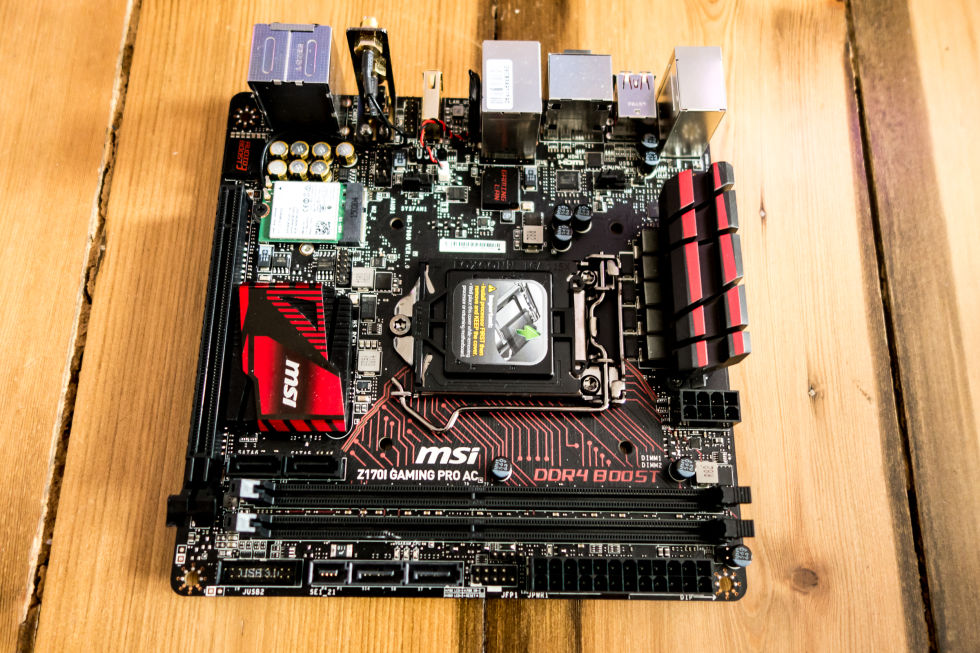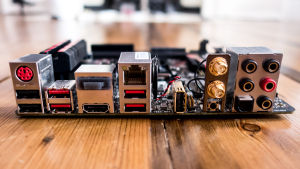
Way back at the beginning of 2015 I tasked myself with building a gaming PC for the living room. 12 months later and finally—after coming to work for Ars, travelling halfway around the world a few times over, and patiently waiting for someone to release a console-like case that didn't suck—it is done.
As is usually the case when embarking on some half-baked idea to use technology to improve your life—or in my case, provide a prettier way to procrastinate—there's a tendency to over-complicate things. Case in point: I already had a PC in my living room; a very old, very loud, but still perfectly functional HP Microserver that I used as a NAS and media player. The gaming PC could replace the media player part, but what about the storage?
So I needed a gaming PC, and some sort of network-attached storage (NAS)—either one built out of old parts, or something shiny and new from Amazon. Then I remembered that thanks to my recent acquisition of various bits of IoT gear, adding two new devices instead of one would leave me short an Ethernet socket—and no, even with a router capable of 802.11ac, Wi-Fi still doesn't trump good ol' fashioned cables for speed and reliability.
So that's a gaming PC, a NAS, and a new Ethernet switch. Oh, and I needed new power strips, because it turned out I'd ran out of sockets. Like I said: tech tends to get complicated.
The trouble with PC cases
Fortunately, the power strips and the unmanaged 8-port Ethernet switch were easy fixes, bar the laborious process of rewiring everything. The gaming PC however, was trickier. The basics are simple enough: a minimum of an Intel i5 processor, a decent amount of RAM and storage, and a good graphics card. The was one obvious complication, though: because the box will be located in the living room, it needs to be as discreet and as quiet as possible.
There are some pre-built options. Alienware's Alpha, for instance, is a tiny and surprisingly understated machine—for Alienware at least—that sports a Core i5-4590T, 8GB of RAM, and 1TB hard drive for £630 (cheaper models with an i3 and less RAM are available). However, the custom 2GB Nvidia GPU it ships with isn't upgradable, and is roughly as powerful as 860M mobile chip. That's fine for 1080p at medium or high settings, but not enough to outclass consoles, and certainly not enough to drive the 4K TV I'd be plugging it into.

The step up from the Alpha, Alienware's X51, is a better option, but expensive when you consider the £630 model only comes with an i3 processor and terrible Nvidia GTX 745 graphics card. Jumping up to the model with a far better AMD Radeon R9 370 and Core i7 pushes the price up to just shy of £1000. That's not to mention that, while you can upgrade the graphics card, you're limited by space and the custom power supply.
The X51's form factor is a good one, though, the thin vertical arrangement being far more appealing than the cube-shaped PCs that tend to dominate small-form-factor (SFF) builds. Thanks in part to Valve's Steam Machine initiative, case manufacturers are finally starting to offer vertical cases for building small PCs using off-the-shelf parts.
Silverstone, for instance, has the very-well-reviewed RVZ01 mini-ITX case, which I'd have used if it weren't for the fact that it's still quite large by SFF standards. Next on the list was Fractal's Node 202, a case I'd initially settled on thanks to its understated look and clean internal design. Unfortunately, getting hold of a Fractal 202 proved tricky thanks to a complete lack of stock here in the UK.
Then, come October, Overclockers UK gave me a nudge and told me about an update to the RVZ01, the RVZ02—and it was glorious. Not only is the RVZ02 slimmer than both the RVZ01 and Core 202 at just 87mm, it's relatively cheap at around £76. There's space inside for two 2.5-inch drives, graphics cards up to 33cm long and 12cm wide (making it compatible with basically all of them), and it sports a pleasingly sharp, but subtle design.
There's always a catch
Naturally, there are some compromises. For starters, there are no external cooling fans at all on the RVZ02. The GPU and CPU rely on their built-in fans alone to stay cool, which risks throttling, and certainly rules out any extreme overclocks. The CPU cooler can't be taller than 58mm either. The RVZ02 also only works with smaller SFX or SFX-L power supplies, which tend to be pricier than their ATX counterparts. Despite all that, the RVZ02 remains one of the better options for a slim case that takes a full-size graphics card.
-
The sides of the RVZ02 feature removable dust filters for easy cleaning.
-
Another removable dust filter on the other side of the case.
-
The front of the case has a sharp look.
-
Hidden behind a sliding cover are two USB 3.0 ports, a headphone jack, and a microphone jack.
-
The rear of the case has cutouts for the PSU, IO, and GPU.
-
With the side panels off, the main compartment is revealed and features plenty of room for a SFX-L PSU, mini-ITX motherboard, and two 2.5-inch hard drives,
-
The other side of the case features a huge GPU compartment, along with access to the back of the motherboard for easy CPU cooler removal.
| SYSTEM SPECIFICATIONS | |
|---|---|
| OS | Windows 10 |
| CPU | Intel Core i7-6700K |
| RAM | 16GB Kingston HyperX @2400Mhz |
| HDD | 256GB Samsung 940 Pro, 1TB Seagate SSHD |
| Motherboard | MSI Gaming Z170I mini-ITX |
| Power Supply | Silverstone SFX-L 500W |
| Cooling | Silverstone SST-AR06 |
| Case | Silverstone RVZ02 |
| Graphics | Nvidia GTX Titan X |
Working inside the case is a breeze, something that can't be often be said for mini-ITX cases. The two side panels slide off to reveal a surprisingly large compartment for a motherboard, PSU, two tool-free 2.5-inch drive mounts, and a slimline optical mount, while the other side has a space for a GPU that sits on an included riser card. It's an odd configuration, but it keeps the case slim, and the CPU and GPU well apart, which helps with keeping them both cool. It's worth noting that the clear plastic version of the case doesn't feature any dust filters on the side panels, which—given they're primary air intake for all the components—is a strange omission. Happily, the model with black side panels does, so if you do buy a RVZ02, be sure to get that version.
There are other nice touches throughout that make installation easier: pre-installed motherboard standoffs, a large cut-out behind the CPU for cooler installation, and plenty of space around the PSU to mount cables. Even using a larger SFX-L PSU—which, until Corsair gets its act together and releases its 600W SFX PSU, is the best SFX-sized PSU going thanks to its larger and quieter 120mm fan—works without issue. Cable management is always going to be a struggle in slim case, but I was pleasantly surprised to find that there's ample space around the PSU to stash any excess cable.
Sticking with the Silverstone theme, I opted for the company's SST-AR06 CPU cooler. While I can't say I like its lurid blue fan, the cooler is the best option for the RVZ02, since it's the maximum height of 58mm, putting the 92mm fan right up against the side panel to suck in air. Something like the Noctua NH-L9i would work too, but it's much shorter at 37mm. For the CPU I used an Intel Core i7 6700k, which might seem like overkill but I plan on hanging onto this PC for a little while. There's a non-"K" version of the chip available if you're not planning to overclock, but the price difference in the UK is negligible.


Housing the CPU is MSI's Gaming Z170I Skylake board. MSI's boards have come on leaps and bounds in recent years, their reliability and stability up there with the likes of Asus and Gigabyte. It has a rich set of features, too, including an Intel i219 NIC, dual-antenna 802.11ac Wi-Fi, and a fully isolated audio PCB. Unfortunately, the M.2 slot is limited to 60mm SSDs, so something like the Samsung 950 Pro won't fit, and there's only USB 3.0 support, not 3.1. Those aren't deal breakers for me, and given just how few mini-ITX Skylake boards are on the market right now—and that it's one of the cheaper ones—the Z170I is a great deal.
The rest of the components are made up of a few bits and pieces I pulled from old PCs, including a 250GB Samsung 840 Pro SSD, a Seagate 1TB SSHD with 8GB of flash storage, and, uhh, an Nvidia Titan X. The Titan X has been sitting largely unused in my workstation/gaming PC (I do most of my gaming on the couch these days), so I figured why not use make better use of it? Plus, it'll be interesting to see how it does without airflow and with the stock Nvidia cooler. If you're doing this build yourself, the cheaper 980 Ti will give you the same performance for way less money, while the 970 is ideal for 1080p. AMD fans should check out the newly released 380X for 1080p, or a Fury for 4K.
The total build cost if using the more sensible GTX 980 Ti is around £1300 (probably about $1600 in the US). With the Titan X it comes to around £1600. Considering the specs, that's far better value than a pre-built machine.
reader comments
221